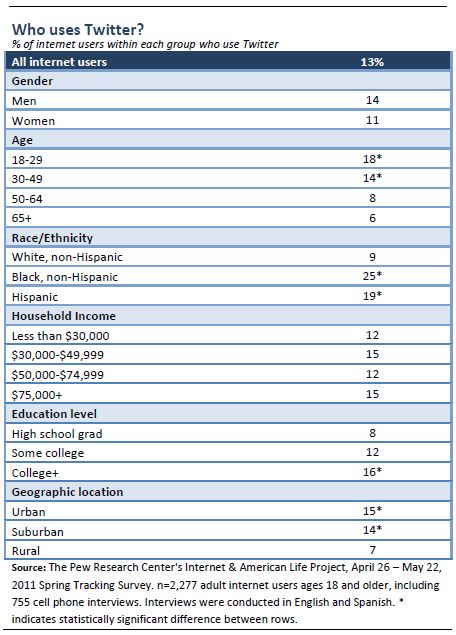 A report published on Wednesday by Pew Internet has confirmed the growing popularity of Twitter among the American population. The report showed that 13 percent of online adult Americans now use Twitter (up from 5 percent in November 2010), and that of those, half access the service using a phone.
A report published on Wednesday by Pew Internet has confirmed the growing popularity of Twitter among the American population. The report showed that 13 percent of online adult Americans now use Twitter (up from 5 percent in November 2010), and that of those, half access the service using a phone.
As for the gender split, slightly more males (14 percent) are using the micro-blogging service than females (11 percent). Looking at the ages of users, of 18-29 year olds who are online and living in the US, 18 percent use Twitter, and for the 30-49 age range 14 percent do so. Silver surfers (65+) are also represented, with 6 percent using the service.

It says that in November 2010 there was a difference of 8 percent in Twitter use between African-American and white Internet users (13 percent for African-Americans compared to 5 percent white). By May 2011, however, the gap had grown to 16 percent, with 25 percent of online African-Americans now using Twitter, compared with 9 percent white. “African-American and Latino Internet users are each significantly more likely than whites to be Twitter adopters,” Pew’s report states. It continues: “Even more notable: One in ten African-American Internet users now visit Twitter on a typical day—that is double the rate for Latinos and nearly four times the rate for whites.”
The report also shows that there has been a big jump in usage in the 30-49 age range – with usage by that age group doubling from 7 to 14 percent since November last year.
Twitter’s popularity and growth shows no sign of slowing. The company recently unveiled a new ‘Follow’ button to make it easier to follow and be followed and a service allowing easier publication of photos. Late last month Twitter acquired third-party client TweetDeck for a sum thought to be in the region of $40 million.
Pew Internet’s survey involved 2,277 adults, aged 18 and over, who were contacted by phone during April and May this year.
